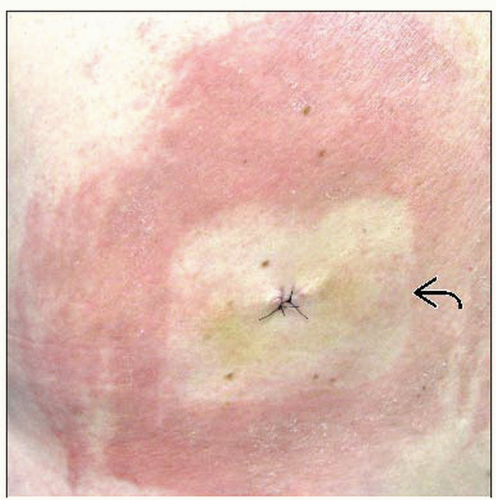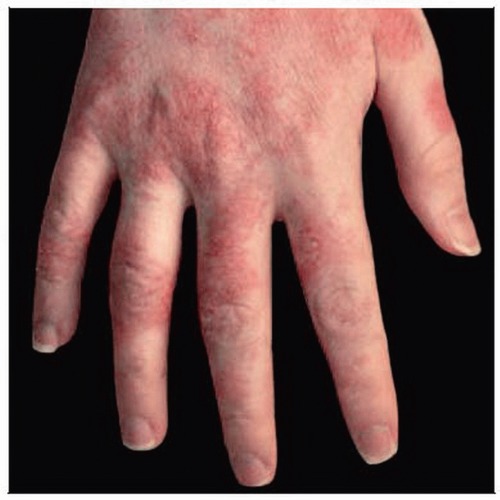Contact Dermatitis
George R. Collins, DO
Joseph Susa, DO
Clay J. Cockerell, MD
Key Facts
Terminology
Allergic contact dermatitis (ACD): Inflammatory skin disorder initiated by contact with an allergen to which the person has already been sensitized
Irritant contact dermatitis (ICD): Inflammatory skin condition produced in response to non-immune-mediated direct toxic effect of chemical or physical irritant substance damaging the skin barrier
Clinical Issues
Prevalence of contact dermatitis (irritant and allergic) in USA varies from 1.5-5.4%
In USA, rhus dermatitis due to poison ivy/oak/sumac causes more cases of ACD than all other allergens combined
ICD is most common job-related skin disease
Diagnostic Checklist
Allergic and irritant contact dermatitis may appear histologically similar, which makes separation difficult
Acute ACD shows prominent spongiosis with vesicles, neutrophils, superficial perivascular lymphohistiocytic dermal infiltrates with eosinophils and no epidermal necrosis
Chronic ACD may show parakeratosis, minimal spongiosis, epidermal hyperplasia, and may even resemble lichen simplex chronicus
ICD shows epidermal necrosis, ballooning, dyskeratotic keratinocytes, and less spongiosis, but features vary and may simulate ACD
Clinical correlation is helpful for proper diagnosis
TERMINOLOGY
Abbreviations
Allergic contact dermatitis (ACD)
Irritant contact dermatitis (ICD)
Synonyms
Hand dermatitis, diaper rash, and chemical dermatitis refer to types of irritant contact dermatitis
Allergic contact dermatitis may be referred to as eczematous dermatitis by some clinicians
Definitions
Contact dermatitis is a generic term for acute or chronic inflammatory reactions to substances that come in contact with the skin
ACD
Inflammatory skin disorder initiated by contact with an allergen to which the person has already been sensitized
Caused by cutaneous type IV cell-mediated delayed hypersensitivity allergic reaction
ICD
Inflammatory skin condition produced in response to non-immune-mediated direct toxic effect of chemical or physical irritant substance damaging the skin barrier
Irritants cause damage in many ways such as removal of surface lipids, damage of cell membranes, denaturation of epidermal keratins, cytokine release, and direct cytotoxic effect
ETIOLOGY/PATHOGENESIS
Environmental Exposure
ACD
Depends on sensitization, usually requires at least 2 exposures to exogenous antigen, and occurs only in sensitized individuals
Depending on degree of sensitization, even small amounts of antigen can elicit a reaction and sensitization may occur after only 2 exposures
Common allergens include nickel, fragrances, cosmetics, urushiol found in Rhus and Toxicodendron spp. (poison ivy/oak/sumac), formaldehyde, topical antibiotics, latex, rubber, balsam of Peru
ICD
Acute form can occur upon even a single exposure to toxic agent with severe cases resulting in necrosis
Effects depend on concentration of toxic agent with strong chemicals causing immediate reactions
Commonly due to repeated or continuous exposures to alkaline soaps/detergents, organic solvents, and excess moisture (hand, diaper area, colostomy site)
Common irritants include acids, alkalis, cement, metal salts, phenols, kerosene, ethylene glycol, lime acids, plants, alcohol solvents, acetone, fiberglass
CLINICAL ISSUES
Epidemiology
Incidence
Prevalence of contact dermatitis (irritant and allergic) in USA varies from 1.5-5.4%
ACD
Affects a limited number of sensitized people, yet it is common and accounts for up to 20% of all cases of dermatitis in children
Sensitization to nickel is the leading cause of allergic contact dermatitis worldwide
In USA, rhus dermatitis due to poison ivy/oak/ sumac causes more cases of allergic contact dermatitis than all other allergens combined
ICD
Age
Allergic and irritant contact dermatitis affect any age
Gender
Allergic and irritant contact dermatitis show no overall significant gender predilection
Site
ACD
Localized to 1 region or generalized in random pattern or on exposed areas
Initially confined to area of allergen contact and may be linear
ICD
Acute forms may be localized or generalized depending on nature of contact with toxic agent; chronic form commonly affects hands
Presentation
ACD
Immune-mediated reaction that may spread to involve adjacent skin or even beyond affected site with rare generalized involvement
Affects a limited number of people previously sensitized by typically low molecular weight antigens that easily penetrate the stratum corneum
Rapid onset once sensitized usually 12-48 hours after antigen exposure and persisting up to 3-4 weeks
Can occur with as few as 2 exposures (poison ivy) or require many exposures with weaker allergens
Intense pruritus and even pain with fever and acute illness syndrome in severe cases
Appearance of skin lesions depends on severity and location and evolves over time
Acute: Well-demarcated erythematous plaques and edema with superimposed vesicles &/or papules with bullae and confluent erosions in severe cases
Stay updated, free articles. Join our Telegram channel

Full access? Get Clinical Tree





